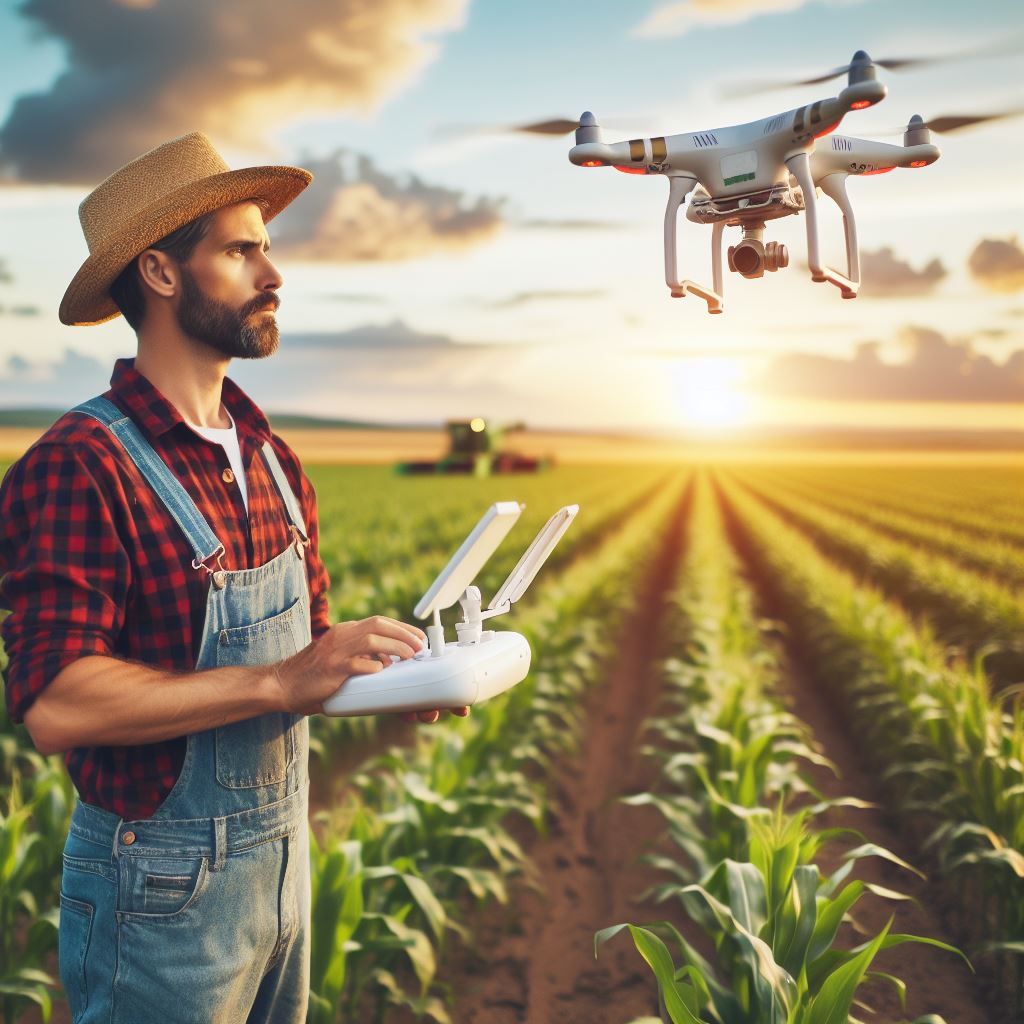Introduction
Reducing farming’s carbon footprint, specifically addressing the Farming Carbon Footprint, is crucial in the fight against climate change and ensuring a sustainable future for agriculture.
A carbon footprint is the total amount of greenhouse gases emitted by an individual, organization, or industry.
In farming, it includes emissions from machinery, livestock, fertilizers, and land use change.
Importance of reducing carbon footprint in farming
Reducing farming’s carbon footprint is essential for several reasons.
Firstly, agriculture is a significant contributor to greenhouse gas emissions globally.
Secondly, decreasing emissions can help mitigate climate change and its adverse effects on agriculture.
Finally, it promotes environmental sustainability and ensures a healthier planet for future generations.
Overview of the blog post’s content
This blog section will explore various ways to reduce farming’s carbon footprint.
We will discuss sustainable farming practices, such as precision agriculture and organic farming, that minimize greenhouse gas emissions.
Moreover, we will delve into the importance of soil health management techniques, crop diversification, and efficient water management in mitigating emissions.
Additionally, we will highlight the role of renewable energy sources and innovative technologies in lowering farming’s carbon footprint.
Finally, case studies of successful initiatives and governmental policies promoting carbon neutrality in agriculture will be discussed.
By implementing these strategies and adopting climate-smart farming practices, we can significantly reduce farming’s environmental impact of carbon emissions, improve agricultural sustainability, and contribute to a greener and healthier planet.
Understanding the Impact of Farming on Climate Change
Farming plays a significant role in contributing to greenhouse gas emissions.
Statistics on farming’s contribution to greenhouse gas emissions
- Agriculture is responsible for approximately 14% of global greenhouse gas emissions.
- Livestock farming alone contributes almost two-thirds of the agricultural sector’s emissions.
- Methane and nitrous oxide, released from livestock and soil, have higher global warming potentials than CO2.
- Cattle farming is the largest single source of methane emissions.
Different farming practices affect the carbon footprint
- Deforestation for agriculture increases carbon emissions due to the loss of carbon sinks.
- Pesticides and chemical fertilizers used in conventional farming release greenhouse gases.
- Irrigation, if not managed properly, leads to carbon emissions from energy-intensive water pumps.
- Intensive livestock farming produces more emissions than sustainable pasture-based systems.
- Methane emissions from rice paddy fields can be reduced by improving water and fertilizer management.
Importance of sustainable farming methods
Sustainable farming practices can mitigate the negative impact of agriculture on climate change.
Advantages of sustainable farming
- Carbon sequestration through organic farming techniques helps offset emissions.
- Crop rotation and cover cropping improve soil health and reduce the need for synthetic fertilizers.
- Precision agriculture techniques minimize resource use and optimize yields.
- Agroforestry systems integrate trees with crops, enhancing carbon storage and biodiversity.
- Efficient water management reduces energy consumption and associated carbon emissions.
- Integrated pest management reduces reliance on pesticides and lowers associated emissions.
Policies and initiatives promoting sustainable farming
- Government subsidies for sustainable practices encourage farmers to adopt climate-friendly methods.
- Certification programs such as organic or fair-trade promote environmentally sound farming practices.
- Research and development focus on innovative approaches for reducing agriculture’s carbon footprint.
- Education and awareness campaigns raise public understanding of the link between farming and climate change.
- Collaboration between farmers, scientists, and policymakers drives the transition to sustainable agriculture.
In fact, farming significantly contributes to greenhouse gas emissions.
Understanding the impact and implementing sustainable agriculture methods are crucial steps towards reducing agriculture’s carbon footprint.
Practices for Reducing Carbon Footprint in Agriculture
In order to reduce farming’s carbon footprint, there are several practices that can be implemented:
Transitioning to organic farming
By transitioning to organic agriculture , farmers can significantly reduce their carbon footprint.
Organic farming eliminates the use of synthetic fertilizers and pesticides, which are energy-intensive to produce and release greenhouse gases during their manufacturing process.
By using natural fertilizers and pest control methods, organic farmers can reduce the release of carbon dioxide and other harmful greenhouse gases into the atmosphere.
Implementing crop rotation and cover cropping
In addition to organic farming, implementing crop rotation and cover cropping practices can further reduce carbon emissions in agriculture.
Crop rotation involves alternating different crops on the same piece of land, which helps break pest and disease cycles, reducing the need for chemical inputs.
Cover cropping involves planting cover crops like legumes or grasses during periods of fallow to protect and enrich the soil.
These practices improve soil health by increasing organic matter, leading to carbon sequestration in the soil.
Minimizing tillage and adopting conservation tillage methods
Minimizing tillage is another effective method for reducing farming’s carbon footprint.
Traditional tillage practices disrupt the soil structure and release significant amounts of carbon stored in the soil into the atmosphere.
By reducing tillage or adopting conservation tillage methods such as no-till or reduced-till, farmers can preserve soil organic matter and minimize carbon loss.
These practices also help improve soil water retention and reduce erosion, further contributing to sustainability.
Using precision agriculture techniques and smart irrigation systems
Precision agriculture techniques and smart irrigation systems can also play a crucial role in reducing carbon emissions.
Precision agriculture involves using advanced technologies like GPS mapping and sensors to precisely apply fertilizers, pesticides, and water only where and when needed.
This reduces waste and minimizes the use of inputs, resulting in lower energy consumption and greenhouse gas emissions.
Smart irrigation systems use real-time data to optimize water use, preventing over-irrigation and water wastage, thus reducing energy requirements and associated carbon emissions.
In short, reducing farming’s carbon footprint requires the adoption of various practices.
Transitioning to organic farming, implementing crop rotation and cover cropping, minimizing tillage, and using precision agriculture techniques and smart irrigation systems can all contribute to sustainable agriculture.
By implementing these practices, farmers can significantly reduce carbon emissions, preserve soil health, and contribute to a greener and more sustainable future.
Read: Soil pH and Its Impact on Crop Growth
Transform Your Agribusiness
Unlock your farm's potential with expert advice tailored to your needs. Get actionable steps that drive real results.
Get StartedAlternative Energy Sources for Farms
In order to reduce farming’s carbon footprint, it is important to consider alternative energy sources that can be implemented on farms.
These sources, such as solar panels and wind turbines, have proven to be beneficial in reducing carbon emissions.
Let’s explore the advantages and success stories associated with utilizing these energy sources in farming.
Utilizing Renewable Energy Sources like Solar Panels and Wind Turbines
Solar panels and wind turbines are two popular renewable energy sources that can be effectively used on farms.
Solar panels convert sunlight into electricity, while wind turbines convert wind energy into electrical power.
Both of these sources are readily available and can be harnessed to generate clean energy.
Benefits of These Energy Sources in Reducing Carbon Emissions
By utilizing renewable energy sources like solar panels and wind turbines, farms can significantly reduce their carbon emissions.
Unlike traditional energy sources such as fossil fuels, these renewables do not produce greenhouse gases during operation.
This helps in combating climate change and creating a more sustainable farming industry.
Success Stories and Examples of Farms Using Alternative Energy
Numerous farms around the world have successfully implemented alternative energy sources to minimize their carbon footprint.
One notable success story is Green Acres Farm, located in California.
They installed solar panels, which now provide over 90% of their energy needs, leading to a substantial reduction in carbon emissions.
Another inspiring example is Windy Meadows Farm in Texas.
They have installed wind turbines that generate clean electricity, allowing them to power their operations without relying on fossil fuels.
This has not only reduced their carbon footprint but also reduced their energy costs in the long run.
Additionally, Farms for the Future, a collective of organic farms in the UK, has made significant strides in utilizing renewable energy sources.
By incorporating solar panels and wind turbines, they have successfully reduced their carbon emissions by 50% compared to conventional farming practices.
These success stories serve as shining examples of how alternative energy sources can be harnessed on farms.
Not only do these sources contribute to the environmental wellbeing of the planet, but they also offer economic and financial benefits to the farmers.
In general, alternative energy sources such as solar panels and wind turbines offer a sustainable solution to reduce farming’s carbon footprint.
With their ability to generate clean electricity without emitting greenhouse gases, these sources have the potential to revolutionize the agricultural industry.
By following the footsteps of successful farms, more farmers can adopt these technologies and contribute towards a greener and more environmentally friendly future.
Read: Cotton Cultivation: Best Practices and Tips

Promoting Biodiversity and Natural Habitat Preservation
Biodiversity is an essential component in reducing farming’s carbon footprint by aiding carbon sequestration.
Exploring the role of biodiversity in carbon sequestration can help us understand its importance in mitigating climate change.
Implementing practices that enhance biodiversity on farms can significantly contribute to reducing carbon emissions.
Creating wildlife habitats and preserving natural areas on farms can promote biodiversity and natural habitat preservation.
Exploring the role of biodiversity in carbon sequestration
Biodiversity plays a crucial role in carbon sequestration, which is the process of capturing and storing carbon dioxide from the atmosphere.
Diverse ecosystems, such as forests, wetlands, and grasslands, act as carbon sinks, absorbing and storing significant amounts of carbon.
By fostering biodiversity, farmers can encourage the growth of vegetation that absorbs carbon dioxide during photosynthesis, thus reducing greenhouse gas levels.
Furthermore, diverse ecosystems also facilitate nutrient cycling, soil formation, and the retention of water, contributing to sustainable agricultural practices.
Implementing practices to enhance biodiversity on farms
Farmers can adopt several practices to enhance biodiversity on their farms and minimize their carbon footprint.
Firstly, they can implement agroforestry techniques, which involve planting trees and shrubs alongside crops or livestock.
This approach offers various benefits, including improved soil health, increased biodiversity, and enhanced carbon sequestration.
Additionally, farmers can practice crop rotation and intercropping, which minimize pest infestations and nutrient depletion, while promoting biodiversity.
Using cover crops, such as legumes or grasses, between main crops can also improve soil health, prevent erosion, and foster biodiversity.
Finally, reducing chemical inputs like pesticides and fertilizers promotes a healthier environment for both flora and fauna.
Creating wildlife habitats and preserving natural areas on farms
Farmers can contribute to biodiversity conservation by creating wildlife-friendly habitats and preserving natural areas within their farms.
Creating hedgerows, which are dense rows of shrubs and trees, can provide wildlife corridors, shelter, and food sources for various species.
Building artificial ponds or wetlands enhances biodiversity by attracting amphibians, birds, and insects, creating a balanced ecosystem.
Preserving natural areas such as forests, wetlands, or grasslands, within the farm can safeguard native species and their habitats.
Showcase Your Farming Business
Publish your professional farming services profile on our blog for a one-time fee of $200 and reach a dedicated audience of farmers and agribusiness owners.
Publish Your ProfileBy maintaining these natural areas, farmers contribute to the overall health of ecosystems and promote the conservation of biodiversity.
In review, promoting biodiversity and preserving natural habitats is crucial for reducing farming’s carbon footprint.
By exploring the role of biodiversity in carbon sequestration, implementing biodiversity-enhancing practices, and creating wildlife habitats, farmers can play an active role in combating climate change.
These efforts not only reduce greenhouse gas emissions but also contribute to the overall sustainability and resilience of agricultural systems.
Read: Integrated Pest Management for Fruit Trees
Delve into the Subject: The Role of Micronutrients in Crop Growth
Find Out More: Microbe Magic: Enhancing Soil Health
Importance of Responsible Livestock Management
In order to reduce farming’s carbon footprint, responsible livestock management plays a crucial role.
It is important to address the carbon footprint associated with livestock production by implementing sustainable feeding practices and reducing methane emissions.
Additionally, encouraging pasture-based systems over intensive confinement operations can contribute to a more sustainable agriculture industry.
Responsible livestock management is essential for reducing farming’s carbon footprint.
Livestock production is a major contributor to greenhouse gas emissions, particularly methane and nitrous oxide.
By adopting responsible practices, farmers can mitigate these emissions and contribute to a more sustainable environment.
One key aspect of responsible livestock management is ensuring the well-being of the animals.
When animals are healthy and well-cared for, they are more efficient at converting feed into meat, milk, or eggs.
This efficiency reduces the overall emissions per unit of production and helps to minimize the carbon footprint associated with livestock farming.
Another important aspect is optimizing feed efficiency.
Livestock feed accounts for a significant portion of the carbon footprint, as it often requires deforestation, transportation, and energy-intensive processing.
By implementing sustainable feeding practices, such as using locally sourced and organic feed, farmers can reduce the carbon emissions associated with feed production.
Addressing the Carbon Footprint Associated with Livestock Production
Livestock production is a significant contributor to global greenhouse gas emissions, accounting for approximately 14.5% of total emissions.
The primary greenhouse gas associated with livestock is methane, which is released during enteric fermentation in ruminant animals.
To address this issue, farmers can implement various strategies to reduce methane emissions.
One approach is to improve livestock diets to make them more digestible, which reduces the amount of methane produced during digestion.
This can be achieved through the use of specialized feed additives or the inclusion of high-quality forages in the animals’ diet.
Another strategy is to implement anaerobic digestion systems, which capture methane emitted from manure and convert it into biogas for energy production.
This not only helps reduce methane emissions but also provides renewable energy for on-farm use or the local grid.
Sustainable Feeding Practices and Reducing Methane Emissions
Sustainable feeding practices in livestock farming can help reduce the environmental impact of carbon emissions.
For example, optimizing the use of by-products from other industries as animal feed can reduce the environmental impact of feed production.
This approach not only minimizes waste but also reduces the need for additional resources.
Furthermore, incorporating legumes and other nitrogen-fixing plants into pastures can enhance soil fertility, reducing the need for synthetic fertilizers.
This, in turn, reduces the carbon footprint associated with fertilizer production and application.
Encouraging Pasture-Based Systems over Intensive Confinement Operations
Promoting pasture-based systems over intensive confinement operations is vital for reducing farming’s carbon footprint.
Pasture-based systems allow animals to graze on natural forage, which reduces the need for energy-intensive feed production and reduces methane emissions.
Additionally, pasture-based systems have environmental benefits beyond carbon footprint reduction.
They can improve soil health, increase biodiversity, and enhance the overall sustainability of the farming system.
This holistic approach to livestock management contributes to a more resilient and environmentally friendly agricultural sector.
In closing, responsible livestock management plays a crucial role in reducing farming’s carbon footprint.
By addressing the carbon footprint associated with livestock production, implementing sustainable feeding practices, and encouraging pasture-based systems, we can create a more environmentally friendly and sustainable agriculture industry.
Read: Hydroponics: Future of Urban Crop Production
Overcoming Challenges and Barriers
In the pursuit of reducing farming’s carbon footprint, farmers encounter numerous challenges and barriers that hinder their transition to sustainable practices.
However, with the right initiatives and support, these obstacles can be overcome.
Challenges faced by farmers in transitioning to sustainable practices
- Lack of knowledge and awareness: Many farmers have limited understanding of sustainable farming methods and their potential benefits.
- Resistance to change: Old habits die hard, and some farmers are reluctant to adopt new practices that deviate from conventional methods.
- Limited access to technology and resources: Transitioning to sustainable practices can be expensive, and not all farmers have the necessary financial means or access to resources.
- Time constraints: Implementing sustainable practices often requires extra time and effort, which can be challenging for farmers already burdened with demanding schedules.
- Dependence on subsidies: Some farmers depend heavily on subsidies for their income, making it difficult for them to invest in sustainable practices without financial stability.
Addressing financial constraints and access to resources
To overcome financial barriers and access resources, several measures can be taken:
- Promote financial assistance programs: Governments and organizations should provide grants, loans, and subsidies specifically targeted at supporting farmers’ transition to sustainable practices.
- Encourage collaboration: Farmers can join cooperative arrangements to pool resources and share costs, easing the financial burden.
- Invest in research and development: Research institutions and agricultural organizations should focus on developing cost-effective sustainable practices and technologies.
- Facilitate knowledge sharing: Creating networks and platforms that enable farmers to exchange experiences and learn from each other’s successes and failures can help address knowledge gaps.
Importance of government support and incentives
Government support and incentives play a crucial role in driving the adoption of sustainable farming practices:
- Policy frameworks: Governments should develop comprehensive policies that prioritize sustainable agriculture and offer incentives for farmers to adopt practices that reduce carbon emissions.
- Financial incentives: Monetary rewards and tax credits can encourage farmers to invest in sustainable technologies and methods.
- Infrastructure development: Governments should support the establishment of necessary infrastructure like renewable energy systems and sustainable irrigation systems.
- Educational campaigns: Government initiatives should focus on educating farmers about sustainable practices, their benefits, and how to overcome associated challenges.
- Partnerships with stakeholders: Collaboration between governments, agricultural organizations, and other stakeholders can help provide farmers with the resources and support they need.
In summary, while farmers face various challenges and barriers in the transition to sustainable practices, overcoming them is crucial for reducing farming’s carbon footprint.
Financial assistance, access to resources, and government support are fundamental in enabling farmers to make this transition successfully.
By addressing these obstacles and providing the necessary tools and incentives, we can empower farmers to contribute to a more sustainable and environmentally friendly agricultural sector.
Conclusion
This blog post has highlighted the various key points regarding reducing farming’s carbon footprint.
We have discussed the importance of collective action in addressing this issue, as well as the role of sustainable practices in making a positive impact.
By implementing sustainable agriculture practices, farmers and readers alike can contribute to reducing the environmental impact of carbon emissions associated with agriculture.
Small steps such as improving soil health, optimizing water usage, and adopting renewable energy sources can make a significant difference.
It is crucial for all stakeholders in the agricultural industry to come together and collaborate in finding solutions to reduce farming’s carbon footprint.
This collective action is necessary to bring about meaningful change and ensure a sustainable future for agriculture.
Ultimately, it is up to each individual farmer to embrace sustainable practices and make the necessary changes in their own operations.
By doing so, they can not only reduce their carbon emissions but also inspire others to follow suit.
Let us all take the initiative and make a conscious effort to implement sustainable farming practices.
Together, we can make a positive impact and help mitigate the environmental challenges associated with farming’s carbon footprint.




